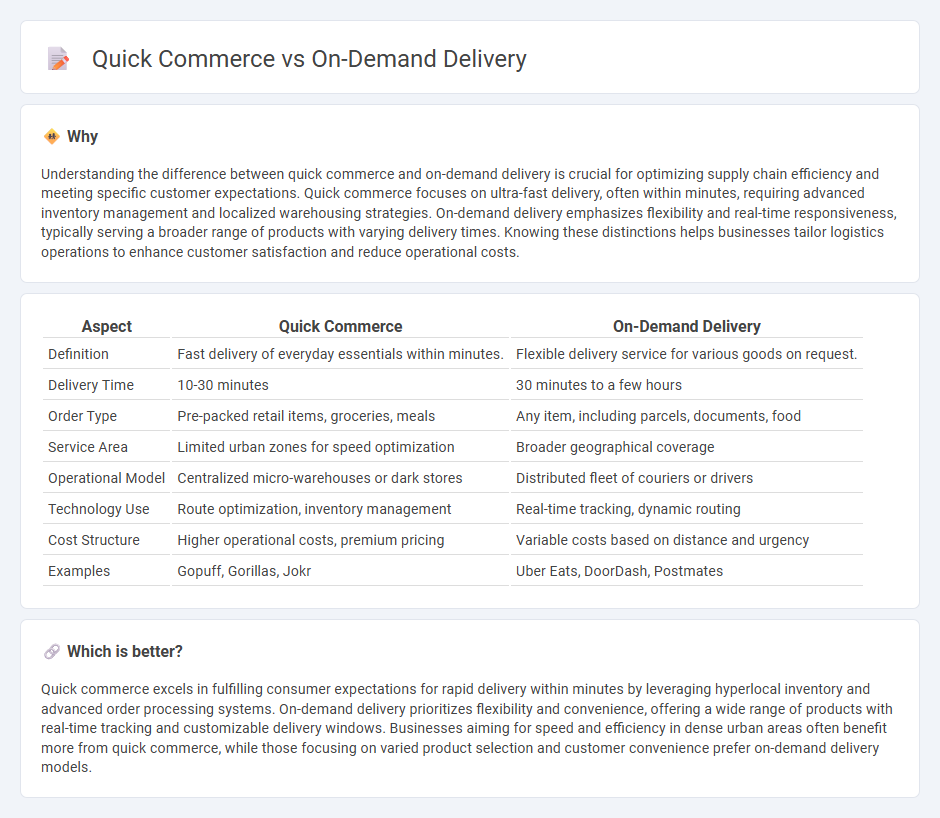
Quick commerce focuses on ultra-fast delivery of everyday essentials within minutes, leveraging local micro-fulfillment centers and advanced inventory management systems. On-demand delivery emphasizes rapid, flexible transport of a broader range of goods or services, utilizing real-time order processing and dynamic routing algorithms. Explore the key differences and benefits of quick commerce and on-demand delivery to optimize your logistics strategy.
Why it is important
Understanding the difference between quick commerce and on-demand delivery is crucial for optimizing supply chain efficiency and meeting specific customer expectations. Quick commerce focuses on ultra-fast delivery, often within minutes, requiring advanced inventory management and localized warehousing strategies. On-demand delivery emphasizes flexibility and real-time responsiveness, typically serving a broader range of products with varying delivery times. Knowing these distinctions helps businesses tailor logistics operations to enhance customer satisfaction and reduce operational costs.
Comparison Table
| Aspect | Quick Commerce | On-Demand Delivery |
|---|---|---|
| Definition | Fast delivery of everyday essentials within minutes. | Flexible delivery service for various goods on request. |
| Delivery Time | 10-30 minutes | 30 minutes to a few hours |
| Order Type | Pre-packed retail items, groceries, meals | Any item, including parcels, documents, food |
| Service Area | Limited urban zones for speed optimization | Broader geographical coverage |
| Operational Model | Centralized micro-warehouses or dark stores | Distributed fleet of couriers or drivers |
| Technology Use | Route optimization, inventory management | Real-time tracking, dynamic routing |
| Cost Structure | Higher operational costs, premium pricing | Variable costs based on distance and urgency |
| Examples | Gopuff, Gorillas, Jokr | Uber Eats, DoorDash, Postmates |
Which is better?
Quick commerce excels in fulfilling consumer expectations for rapid delivery within minutes by leveraging hyperlocal inventory and advanced order processing systems. On-demand delivery prioritizes flexibility and convenience, offering a wide range of products with real-time tracking and customizable delivery windows. Businesses aiming for speed and efficiency in dense urban areas often benefit more from quick commerce, while those focusing on varied product selection and customer convenience prefer on-demand delivery models.
Connection
Quick commerce relies on advanced logistics networks to fulfill on-demand delivery by minimizing lead times and optimizing inventory placement near consumers. Efficient route planning, real-time tracking, and last-mile delivery solutions enable immediate product availability and rapid order fulfillment. This seamless integration of logistics technology accelerates supply chain responsiveness, meeting consumer expectations for near-instant delivery.
Key Terms
Last-Mile Fulfillment
Last-mile fulfillment in on-demand delivery prioritizes speed by connecting local couriers directly with customers for immediate dispatch, often within minutes. Quick commerce leverages hyperlocal warehouses and advanced inventory management to enable ultra-fast delivery times, frequently under an hour, enhancing customer convenience. Explore detailed strategies and technologies that optimize last-mile fulfillment in both delivery models.
Real-Time Inventory
On-demand delivery and quick commerce both prioritize real-time inventory management to meet consumer expectations for fast, accurate order fulfillment. Real-time inventory systems enable businesses to track product availability instantaneously, reducing stockouts and overstock situations while enhancing customer satisfaction. Explore how leveraging real-time inventory can transform your delivery strategy and boost operational efficiency.
Hyperlocal Distribution
Hyperlocal distribution revolutionizes on-demand delivery by enabling rapid fulfillment within a limited geographic radius, minimizing transit times and improving customer satisfaction. Quick commerce (q-commerce) leverages this model with advanced technology and localized inventory to offer deliveries often under 30 minutes. Explore how hyperlocal strategies optimize efficiency and transform consumer expectations in urban markets.
Source and External Links
What is on-demand delivery logistics? How does it work? - FarEye - On-demand delivery uses online platforms to enable retailers and others to sell and deliver items quickly, often within 24 hours, by rapidly dispatching drivers from warehouses to customers' locations for immediate last-mile delivery.
On Demand Delivery | Same Day Courier Services - On-demand delivery provides immediate pickup and transport of time-sensitive packages via professional drivers with rapid response, GPS tracking, and 24/7/365 availability, serving urgent delivery needs throughout the Mid-Atlantic region.
On Demand Delivery Service in Texas - Hot Shot Final Mile - This service offers fast, flexible same-day deliveries across Texas, with a large driver network to handle urgent documents, medical specimens, and last-minute shipments reliably at any time or day.
 dowidth.com
dowidth.com